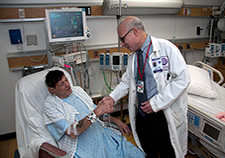Office of Research & Development |
 |

VA Research Currents archive
November 19, 2015

World War II Marine Veteran Stanley Frable, 91, who took part in the COURAGE trial, meets with Dr. Steven Sedlis of VA and NYU Medical Center, whose team just published long-term results from the study. (Photo by Lamel Hinton)
Back in 2007, U.S. and Canadian researchers made headlines when they shared the results of a major study of patients with chest pain during physical exertion, due to blocked arteries.
The trial, known by its acronym COURAGE, found that relieving artery blockage by percutaneous coronary intervention (PCI)—typically, the use of balloon angioplasty plus stenting—did little to improve outcomes for 2,287 patients with stable coronary artery disease who also received optimal drug therapy and underwent lifestyle changes.
The study, led by VA's Cooperative Studies Program and the Canadian Institutes of Health Research, were presented at the American College of Cardiology and published in the New England Journal of Medicine.
On Nov. 12, 2015, the COURAGE group published long-term survival data on a subset of patients from the original study. The initial conclusions appear to hold up: There was no advantage to PCI over optimal medical therapy, at least in terms of staying alive.
The follow-up findings, like those from the original study, were published in the New England Journal of Medicine.
The authors wrote: "During an extended follow-up of up to 15 years, we did not find a difference in survival between an initial strategy of PCI plus medical therapy and medical therapy alone in patients with stable ischemic heart disease."
Lead author on the new report is Dr. Steven P. Sedlis of the New York VA Healthcare Network. Senior author is Dr. William E. Boden of the Upstate New York VA Health Network. Boden led the original trial.
The follow-up included 1,211 patients, just over half of the original study group. The median follow-up was just over six years, but it was as long as 15 years for some patients.
In all, 561 patients died since the start of the study—25 percent of the PCI group and 24 percent in the medical therapy group. The difference was not statistically significant.
The new analysis tracked only one outcome: death from any cause. It is likely some patients died from non-heart-related causes, so that could affect the actual comparison between the PCI and medical therapy group. Also, the study didn't look at outcomes such as ongoing chest pain or quality of life.
Even before the first COURAGE results came out, the American Heart Association had recommended treating stable coronary artery disease with medications and lifestyle changes. Still, the great majority of PCIs in the U.S. were done in those with stable disease—not those who arrived at the emergency room with a heart attack, or who otherwise had unexpected chest pain.
At the time COURAGE was undertaken, the procedure accounted for well over $20 billion annually in U.S. health care costs.
The study involved patients at 15 VA medical centers and 35 non-VA U.S. and Canadian hospitals. Participants—most of them Caucasian males, with an average age of 62—had at least one coronary artery that was more than 70 percent blocked. They experienced regular chest pain, or angina, at least several times per week. About 38 percent had a history of heart attack, 33 percent had diabetes, 71 percent had high cholesterol, and 67 percent had high blood pressure.
All the men and women in the study received optimal medical therapy. This meant medications to lower blood pressure and cholesterol and prevent clots, along with lifestyle programs for smoking cessation, physical activity, and nutrition.
About half the study volunteers also underwent PCI, in which an interventional cardiologist clears plaque from a blocked artery. For almost all the PCI patients, this meant angioplasty, in which a balloon-tipped catheter is used to open up the artery, plus a stent—a wire-mesh tube placed to keep open the affected artery.
Because drug-eluting stents, which are coated with medications that help prevent narrowing of stents by scar tissue, were not approved until the trial was nearly over, only a few COURAGE patients received this type. Findings have been mixed so far on the difference between coated and non-coated stents for the prevention of heart attacks and deaths.
COURAGE is credited with helping to discourage the use of PCI in patients who could probably do just as well with drugs and lifestyle changes. In 2009, the American College of Cardiology, the American Heart Association, and other organizations further promoted this approach with the release of new guidelines for the use of PCI and other treatments for patients with blocked or narrowed arteries.
And in recent years, due to these and other efforts in the medical community, the rates of PCI for those with stable heart disease have in fact declined. A study in the American Journal of Cardiology in 2014 showed a 52 percent decrease in the use of PCI for stable coronary artery disease between 2008 and 2011.
Likewise, a study published Nov. 9, 2015, in the Journal of the American Medical Association found "significant reductions in the volume of nonacute PCI" between 2010 and 2014. Over the course of the study period, the trend was that those patients with stable disease who did get the procedure were more likely to have received anti-angina drugs before undergoing PCI. They were also more likely to have severe chest pain or other signs of higher risk, warranting the use of the invasive procedure.
Still, the COURAGE authors stress that as heart-care technology and treatments continue to evolve, more evidence is needed on the best ways to care for those with stable angina. They point to the ISCHEMIA study, a similar international trial now underway, led by New York University and involving VA and many other collaborators. That effort involves some 8,000 patients treated with the latest technology and is expected to wind down in 2019.